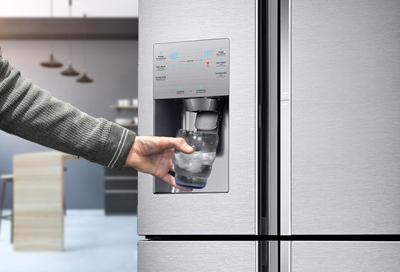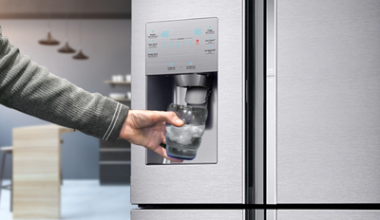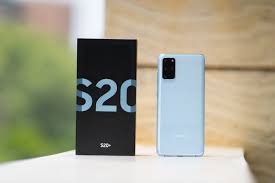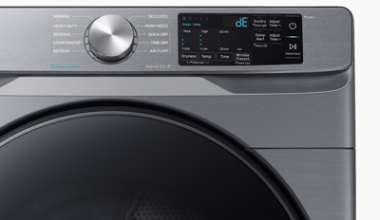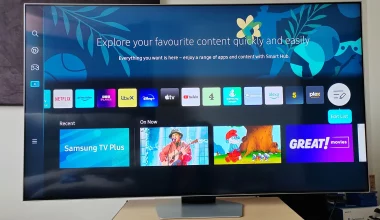To defrost your Samsung ice maker, start by gathering a Phillips head screwdriver, a towel, a small container, a hairdryer, and a plastic spatula. Turn off the ice maker using the control panel, making sure no new ice is dispensed. Carefully remove the ice bin and set it aside. Open the ice maker compartment and use the hairdryer on a low setting to melt the ice, or let it defrost naturally. Gently scrape off any loosened ice chunks. Clean and dry all parts before reassembling securely. With these steps, you’re on your way to a fully functional ice maker.
Gather Necessary Tools
Before you begin defrosting, make sure you have all the necessary tools on hand. You’ll need a few basic items to ensure the process goes smoothly. First, grab a Phillips head screwdriver to remove any panels or covers.
You’ll also need a towel or cloth to wipe up any water that melts during the defrosting process. A small bowl or container will come in handy to catch any excess water.
Next, get a hairdryer or heat gun. This will help speed up the defrosting process. Be sure to keep it on a low setting to avoid damaging any components. A plastic spatula can also be useful for gently scraping off the ice without scratching the surfaces.
Additionally, having a flashlight can be extremely helpful, especially if your ice maker is in a dimly lit area. Don’t forget to have a clean, dry cloth for wiping down the interior once the ice is melted.
Lastly, make sure you have your user manual nearby. It can provide specific guidance tailored to your Samsung model. By gathering these tools ahead of time, you’ll make the defrosting process much easier and more efficient.
Turn Off the Ice Maker
To start, you’ll need to turn off the ice maker to ensure safety and prevent any new ice from forming during the defrosting process. Begin by locating the control panel on your Samsung refrigerator. The ice maker controls are typically found inside the fridge, near the top, or on the door, depending on your model.
Press the button labeled ‘Ice Maker’ or ‘Ice Off.’ If your model has a touch screen, navigate to the ice maker settings and select the option to turn it off. You should see an indicator light or message confirming that the ice maker is now off. This step is crucial because it stops the ice maker from producing more ice, which could interfere with the defrosting process.
Next, make sure the ice maker is completely turned off by checking that no new ice is being dispensed. Wait a few minutes to be certain. If you’re unsure, consult your user manual for specific instructions related to your model.
Remove Ice Bin
Now, carefully pull out the ice bin from your Samsung refrigerator to access the ice maker. Make sure to grip the bin firmly with both hands to avoid any spills or drops. Slide it straight out, keeping it level to prevent any ice from falling. If the bin feels stuck, gently wiggle it side to side to loosen it from its position.
Once you’ve removed the ice bin, set it aside in a safe spot. This will give you clear access to the ice maker, making it easier to inspect and work on. Check the ice bin for any excess ice or water that might’ve accumulated. If there’s any ice buildup, you can go ahead and discard it.
Next, take a closer look at the ice maker area. Ensure there are no obstacles or pieces of ice that could interfere with the defrosting process. This step is crucial for effectively troubleshooting and resolving any issues with your Samsung ice maker.
Keep the ice bin close by, as you’ll need it once the defrosting process is complete. By removing the ice bin properly, you’re setting the stage for a smoother and more efficient defrosting procedure.
Defrost the Ice Maker
With the ice bin set aside, you can start defrosting your Samsung ice maker to resolve any freezing issues. First, make sure the unit is turned off. You don’t want any electrical accidents while you’re working.
Next, open the ice maker compartment to expose the ice-making elements. You might see frost or ice buildup, which needs to be melted away.
Use a hairdryer on the lowest heat setting to carefully melt the ice. Hold the hairdryer about six inches away from the ice buildup and move it in a back-and-forth motion. This ensures the heat is evenly distributed and minimizes the risk of damaging the ice maker’s components.
Alternatively, you can leave the compartment open and let it defrost naturally. This method is slower but eliminates the risk of heat damage. Place towels around the area to catch any water runoff as the ice melts.
If you spot any chunks of ice, gently remove them by hand once they’ve loosened up. It’s important not to use sharp objects to chip away at the ice, as this can damage the unit.
Once the ice is completely melted, you’re ready for the next steps.
Clean and Reassemble
After defrosting, thoroughly clean the ice maker components to ensure optimal performance. This step is crucial as any leftover residue or dirt can affect the quality of your ice and the efficiency of the machine.
Here’s how you can get it done:
- Remove and Wash the Components: Take out all detachable parts from the ice maker, such as the ice bin, ice tray, and any other removable pieces. Wash these parts using warm, soapy water. Make sure to scrub off any ice residue or buildup. Rinse them thoroughly to remove soap.
- Clean the Interior: Use a soft cloth or sponge with warm soapy water to clean the inside of the ice maker. Be gentle yet thorough, ensuring you get into all corners where dirt or ice residue might hide. Avoid using abrasive materials that could scratch the interior surfaces.
- Dry and Reassemble: Once cleaned, dry all the components completely with a clean, dry towel to prevent moisture from freezing and causing issues. Reassemble the parts carefully, making sure everything is securely in place.
Frequently Asked Questions
How Long Does It Take to Defrost the Samsung Ice Maker Completely?
It usually takes about 24 hours for the ice maker to defrost completely. You should unplug the appliance and leave the door open. Make sure to check periodically and remove any excess water that accumulates.
Can I Use a Hairdryer to Speed up the Defrosting Process?
Yes, you can use a hairdryer to speed up the defrosting process, but be careful. Keep it on a low setting and don’t get it too close to avoid damaging the plastic components of the ice maker.
What Are Common Signs That My Ice Maker Needs Defrosting?
You might notice ice buildup around the ice maker, reduced ice production, or strange noises. If your ice cubes are smaller or misshapen, it’s a sign that your ice maker needs defrosting.
Is It Safe to Leave the Ice Maker Defrosting Unattended?
You shouldn’t leave the ice maker defrosting unattended. Water buildup could cause damage or create safety hazards. Stay nearby to monitor the process and address any issues immediately to ensure a safe and smooth defrosting.
How Often Should I Defrost My Samsung Ice Maker to Maintain Optimal Performance?
You should defrost your Samsung ice maker every six months to maintain optimal performance. Regular defrosting prevents ice buildup, ensures efficient operation, and extends the appliance’s lifespan. Don’t forget to unplug it before starting!
Conclusion
You’ve successfully defrosted your Samsung ice maker! By gathering your tools, turning off the ice maker, removing the ice bin, and defrosting it properly, you’ve ensured it will work efficiently.
Now that everything’s clean and reassembled, you’re ready to enjoy fresh ice again. Regular maintenance like this keeps your appliance in top shape.
Great job taking care of your ice maker—cheers to many more cold beverages!
